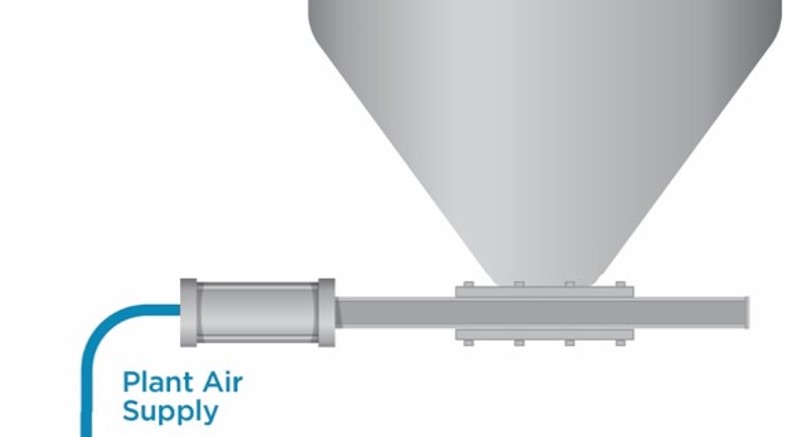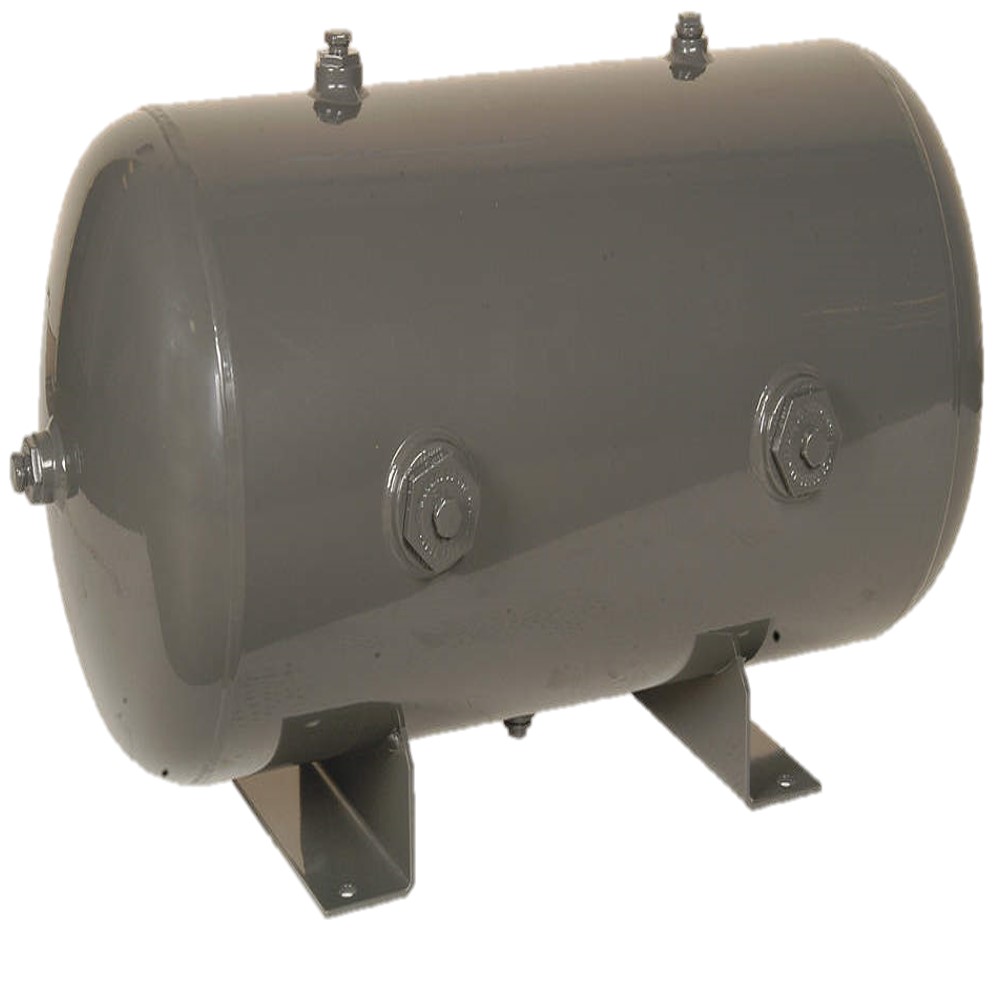
Client:
Quantity:
Size:
Application:
When designing a system for dry bulk material handling, it is important to consider all possible scenarios a slide gate may face during its life cycle – and equip it to appropriately handle those obstacles as they arise. For this reason and as a safety precaution, it is beneficial for a slide gate to be equipped with both a fail-safe air tank and a vented ball valve.
Fail-Safe Air Tanks: How they Work

In traditional setups, a slide gate would be energized through the following steps:
- Plant air is plumbed to provide air supply to the slide gate.
- An air line is connected from the plant air source to the slide gate’s solenoid.
- The solenoid calculates whether the air supply should feed toward the opening or closing stroke, based on commands received from the operator or from a PLC.
- Pressurized air travels through the solenoid and the pneumatic air cylinder, forcing a piston in the pneumatic air cylinder to move either forward or backward. This movement allows the slide gate to actuate open or closed.
With fail-safe air tanks, the same actuation process occurs. However, instead of providing air supply direct from the plant air source toward the solenoid, an air tank is installed between the two.

It changes the process in the following ways:
- Plant air is supplied to the air tank.
- As plant air fills the air tank, that pressure is stored until the tank reaches its maximum storage capabilities.
- When the slide gate is signaled to actuate, air pressure is released from the fail-safe air tank, toward the solenoid. Any air pressure that was lost in the air tank is then replenished with new plant air.
Fail-safe air tanks are simply a way to store additional air pressure, in preparation for an emergency.
The purpose of a fail-safe air tank is to allow a slide gate to actuate fully closed in the instance of plant air loss. When plant air supply is shut off or lost, fail-safe air tanks have a one-way “check” valve that prevents stored air pressure from leaking backward, toward the plant air source. Then, the fail-safe’s stored air is automatically forced toward the solenoid and through the pneumatic air cylinder, so that the slide gate fails closed.
Fail-Safe Air Tanks: Why they are Important

Fail-safe air tanks are beneficial to safeguarding your manufacturing process because they close a convey line’s moving parts. This forbids materials from moving any further in the manufacturing process until plant air is restored.
The alternative is an open system that cannot be controlled. This creates many concerns, including:
- Bad batches by allowing materials to skip over manufacturing stages.
- Damaged product by allowing materials to travel through the convey line at inappropriate velocities.
- Damaged equipment from excessive material impact.
- Product loss from material spillage at the end of a process.
Fail-safe air tanks are also intended to address safety concerns. If the cause of plant air loss is unknown, maintenance technicians must perform inspections to determine where the error(s) may have occurred. If inspection requires technicians to work near a slide gate, it is important for the gate to be actuated fully closed. Otherwise, if a maintenance technician is still working near a partially open slide gate once plant air is restored, the blade may actuate fully closed and cause serious injury.
But even if a fail-safe air tank has actuated a slide gate into the full close position, once plant air is restored, the gate will immediately become live – allowing it to again start opening and closing quite rapidly. To avoid this additional risk, it is critical for all slide gates to be complemented by a vented ball valve.
Vented Ball Valves: How they Work
If plant air or electricity are lost, a pneumatically-actuated slide gate will be impacted in the following ways:
- If electricity is lost, the slide gate’s solenoid will become inactive. Most Vortex slide gates are built with a single-coil solenoid so that if electricity is lost, the gate will fail into a closed position. However, because plant air remains live, once electricity is restored, the slide gate will immediately begin cycling again.
- If plant air is lost, the slide gate’s air cylinder will be deprived of air pressure and thus, will not have access to the energy necessary to actuate. Once plant air supply is restored, air pressure will be immediately accessible to the air cylinder, which allows the slide gate to suddenly regain normal functionality.
If maintenance technicians are working near the slide gate during either of these conditions, a once idle slide gate may immediately begin actuating and cause serious injury. For this reason, “vented ball” valves are essential to plant safety protocol.
Ball valves are used to prohibit plant air supply from moving toward a slide gate’s pneumatic air cylinder – regardless of if plant air is active or disengaged:

Typical ball valves are successful in blocking off the pressurized side of the air line, but are hazardous in that they do not “bleed” residual air from the process side of the air line. If sufficient air is stored on the process side of an air line during upset condition, a pneumatic air cylinder may be pressurized enough to still be capable of actuating the gate – even after a ball valve has been applied.
To prevent this additional hazard, Vortex sources vented ball valves:

The primary difference between typical ball valves and vented ball valves is that vented ball valves are designed with a “vent” to exhaust any residual air from the process side of the air line. This ensures that even if residual air does become trapped in the process side of the air line, it will be quickly exhausted so that air pressures are too weak for the slide gate to actuate out of command. Once plant air is restored, the closed vented ball valve blocks the pressurized side of the air line to forbid air supply from reaching the air cylinder until a maintenance technician physically re-opens the ball valve.
Vented Ball Valves: Why they are Important

For safety reasons, many ball valves also feature a locking mechanism so that only authorized individuals are capable of operating the ball valve. Thus, vented ball valves are arguably the most important lockout-tagout safety mechanism to consider when using slide gates in a manufacturing process. In fact, Vortex recommends vented ball valves so highly that for safety and legal purposes, a vented ball valve is always quoted alongside each Vortex product.
Why you should have Fail-Safe Air Tanks & Vented Ball Valves in your Manufacturing Process
Based on the topics discussed, if:
- A fail-safe air tank is used to ensure a slide gate will fail into the full-close position.
- A vented ball valve is applied to bleed residual air from the process line and to restrict air supply from continuing toward the gate once plant air is restored.
Then, there is no risk for the slide gate to actuate during maintenance – which is a great asset for employee safety and management piece-of-mind.
For many years, these simplistic devices have been utilized in manufacturing operations worldwide to avoid material waste and system damage, and to better control hazardous working conditions. By investing in safeguard technologies today, companies will benefit tenfold over expensive alternatives, such as lost production, equipment replacement or repair, or lawsuits for employee injury or loss of limb.
For more information on fail-safe air tanks, vented ball valves, and other safety accessories, contact us.













